|
Introduction
Doubtless the name is not going to catch on. It means alluvial ponds. Sumpf is swamp, and that is close enough. So use Swamp or Bog Saucer if that flows a little more smoothly for you. The Schwemmteiche Saucer is a link to a test of a form of energy more than to a known type of saucer design. Its existence is testified to by a wartime witness, a Polish POW who along with 16 to 18 other POWs (both French and Russian) were working in the fields and along the road nearby.
There are a couple of extrinsic and intrinsic comments within his statement that require his account be taken seriously. One of these is the set up he describes. He cannot give the proper words for what he is seeing, but from his descriptions he is accurately describing a known industrial set up. He describes copper cables leading from a columned structure to a large work area concealed behind a tarpaulin wall. He estimated the makeshift wall as 50 feet high and encircled an area up to 150 yards in diameter. From behind it a loud whine began at one point. It caused the engine of their work party’s tractor to stall. A few hours later it happened again. This time the sound wasn’t as sharp. Along with this otherworldly sound, a vehicle rose up vertically from behind the 50-foot tall tarpaulin wall and then coasted off horizontally until obscured by some trees.
He puts no specific descriptive on it other than “vehicle.” He does not say “flying saucer.” But in giving the dimensions as about 75 to 100 feet in diameter and 14 feet high, he is essentially telling us it was saucer-like. It was made of dark gray material (metal). The top 5 or 6 feet and the bottom 5 or 6 feet were stationary. However, the central section was about a 3-foot band and it spun rapidly, so much so it was a blur like that made by a spinning propellor. The most fascinating thing to him was that each time this sound had happened it had caused the tractor’s engine to stall.
Freed from captivity at the end of the war, he immigrated to the US. On November 2, 1957, the UFO events at Levelland were reported around the nation. Along with the reports of the object setting down on the country roads around the small Texas town, there was the unanimous report that the car motors of the witnesses stalled. In response, he contacted Robert Cutler, the assistant to President Eisenhower. The F.B.I. was informed, and interviewed him on November 7, 1957.
The following is
The Account from the F.B.I. Report
At the time he was about 18 years old. He could not remember the month, but it was in 1944. Since they were set to cut hay, we can surmise it was late summer to early autumn. As a Polish prisoner of war he and about 18 other POWs had been formed into a work party and put under the authority of a German supervisor. He recalled the little village nearby. It was Altgolßen (old Golssen), and he believed it was about 30 miles east of Berlin. “While en route to work in a field a short distance north of Gut Alt Golssen, the tractor engine stalled on a road through a swamp area. No machinery or other vehicle was then visible although a noise was heard.” It was a “high pitched whine similar to that produced by a large electric generator.”
At this moment, an S.S. guard “appeared and talked briefly with the German driver of the tractor, who waited five to ten minutes, after which the noise stopped and the tractor engine was started normally.”
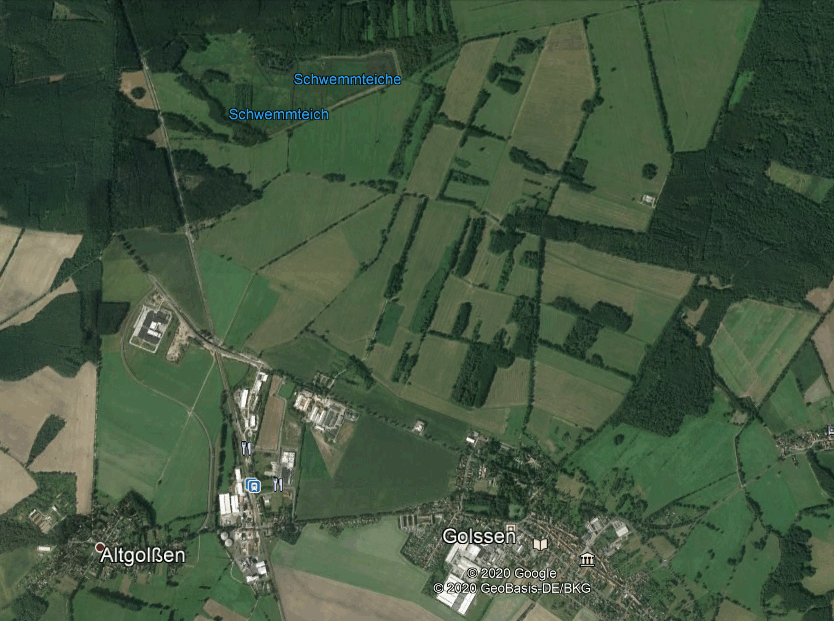
Altgolßen today, and the swamp area labeled Schwemmteiche (alluvial ponds) to the north, just as the Polish POW remembered. Below, a closer look at the swampy area. A couple of dirt roads still lead around it, into and along the forest and dike by the fields, and back to the road by the railroad tracks.
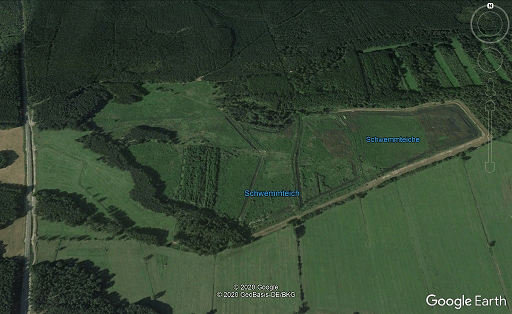
About 3 hours later, “in the same swamp area,” the work party was cutting hay along the road. The witness, on the other hand, was further from the road and not under as strict supervision. The sound started again. It was lower pitched but similar to the earlier sound. The tractor motor stalled again, and this time the driver didn’t bother to try to restart it. The group of S.S. guards seemed used to it and they remained routine. Because he and a few others were further from the group they got a furtive look at something strange. He “observed a circular enclosure approximately 100 to 150 yards in diameter protected from viewers by a tarpaulin-type wall approximately 50 feet high, from which a vehicle was observed to slowly rise vertically to a height sufficient to clear the wall and then to move slowly horizontally a short distance out of his view, which was obstructed by nearby trees.”

A bland interpretation of what the POW saw.
The vehicle, observed from approximately 500 feet, was described as circular in shape, 75 to 100 yards [sic, feet] in diameter, and about 14 feet high, consisting of a dark gray stationary top and bottom sections, 5 to 6 feet high. The approximate 3 foot middle section appeared to be a rapidly moving component producing a continuous blur similar to an aeroplane propellor, but extending the circumference of the vehicle so far as could be observed. The noise emanating from the vehicle was similar but of a somewhat lower pitch than the noise previously heard [high pitched whine similar to an electric motor]. The engine of the tractor again stalled on this occasion and no effort was made by the German driver to start the engine until the noise stopped, after which the engine started normally.
Whatever was going on, it was a rather elaborate though makeshift operation. On this and other occasions, he had noticed “un-insulated metal, possibly copper, cables one and one half inch to two inches in diameter, on and under the surface of the ground, in some places covered by water . . . apparently running between the enclosure and a small concrete column-like structure between the road and enclosure.”
He and his fellow Pole, Russian, and French POWs “had discussed the incident among themselves many times.” None, apparently, worked the location again. Yet he did decide to visit the location soon after the war ended, “when he observed the cables had been removed and the previous locations of the concrete structure and enclosure were covered by water . . .”
This is essentially the story. He could only remember one other POWs’ name, which he gave the agent. This other witness was living in Poland.
Extrinsic and Intrinsic Clues
Only one error is found in terms of topography, and this is the location of Altgolßen. It is not 30 miles east of Berlin, but about 50 miles south of Berlin. However, in specifics, he correctly remembers the swamp area as to the north of the village, roads through it and a forest or stands of trees next to it. It is largely untouched to this day, as the Google screencaps above demonstrate.
Many interesting statements are contained in the greater testimony of the POW. In considering this case, it might be best to first bring up the extrinsics that bear upon it and support incidental statements therein. For example, by this time in 1944 the S.S. was in charge of all the special weapons developments in Germany, and the POW correctly reports that S.S. guards were protecting the site.
Another extrinsic comes from a 1959 book by a former S.S. Major, Rudolf Lusar. First published in Britain, German Secret Weapons of World War Two was a surprising bestseller. He states that Germany did indeed develop flying saucers during the war. He even gives the names of some of the German flying saucer designers. Lusar says that these saucers were developed in Prague. One designed by Dr. Richard Miethe was 42 meters in diameter. Another, designed by Rudolf Schriever and Otto Habermohl, achieved flight status. He too believed this was near Prague. It climbed to an altitude of 37,000 feet (within 3 minutes) and reached a speed of 1,200 mph in horizontal flight.
Since most of the information was destroyed by the retreating S.S. to keep it from falling into Soviet hands, there is much that is not yet proven about Lusar’s accounts, especially about the test location being near Prague. Different information reached Italian engineer Renato Vesco, which may bear upon the location of actual flight tests.
Aside from being an engineer, Vesco had an interest in explaining all UFOs as originating in World War II Axis designs in Italy and Germany. Over the years he developed many contacts who had worked on the novel projects. In the 1960s he started writing about it in order to explain the UFO phenomenon. By 1971 one of his books was translated into English: Intercept— But Don’t Shoot. He described in detail “Foo Fighters” under the name Feuerball. He said in daytime they were silver spinning discs. But at night they looked like a fireball because they contained a rich fuel mixture with added chemicals. These discs carried fancy electromagnetic gear that was designed to fritz the radar and even stall the engine system of allied bombers. They were radio controlled and would home in on the exhaust trail and pace the bombers close up.
If that was the designed intent of the foo saucer, it certainly wasn’t big enough to do the job. Allied bomber pilots and crews describe the glowing orbs zooming in and then pacing them before flitting off. Aside from understandable awe and consternation, they had no other effect on the crews and no effects on the planes.
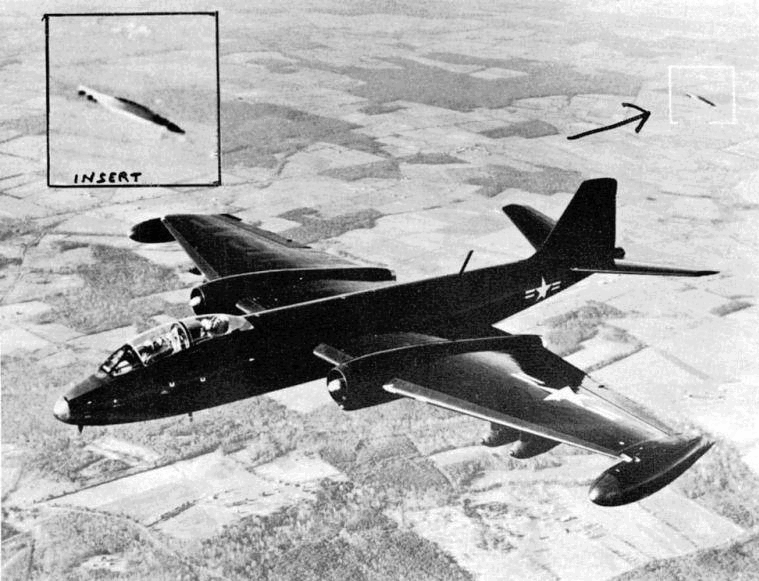
A famous photo showing a small silver disc stalking the exhaust trail of a B-47 bomber, taken by a Convair test pilot in September 1957. Officially, it has never been explained, but the disc matches the Feuerball described by Vesco, indicating the truth of his other comments that the British and Americans captured the technology and sometimes experimented with it.
More than one type of foo device seems to have been made by the Germans, including a round version. Based on POW interrogation, USAAF Intelligence reports describe the round ones as Phoo Bombs. They were steel-nosed ramming devices with a top speed of 525 mph (jet propelled) and an fuel endurance of 25 minutes. Phoo bombs never really worked either. Unless 100 to 200 were launched against a formation, Intelligence didn’t think they were anything to worry about. And since they were being observed at night, we have no way of knowing which of the glowing lights were foo fighters and phoo bombs. Intelligence thought they were only capable of “antics.”
The reason I digress above is that Vesco states a manned version of the above discus was made called the kugelblitz— ball lightning fighter. He says this was flown in the vicinity of Kahla in Thuringia— not near Prague. Now, magnify the small Feuerball disc into a manned saucer and basically this is what the Polish POW saw rise from the swampy area. Something this size could most certainly stall bombers, and perhaps that was its purpose. If several were to come into an Allied bomber formation, they could stall and blow the engines merely by their proximity.
Kahla has a lot in common with Altgolßen. It is a small German village about equidistant from Prague or Gablonz as is Altgolßen. Kahla is on the river Saale and it too has a swampy area to its east. Allied bombing had caused the S.S. to move some sensitive tests to remote locations. One example is the move of scientists from Vienna to the small Austrian village of Leonstein. Perhaps Lusar believed the test flights occurred near Prague because that was a center of development. But putting together all the above sources, the test flights seem to have occurred far from where the allies would even think to bomb. 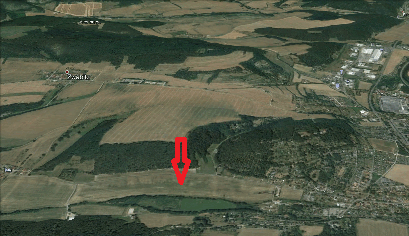
Largely filled in today, the surrounding fields mark the swampy area east of Kahla.
Water and a remote location appear to be important to the test of the saucer. The cement columned structured mentioned by the POW sounds very much like the base of an industrial water cooling tower. He mentions nothing within the columned structure, and there would be none in a cooling tower. There is only the warm water falling from the top of the hollow tower, being cooled by the air blowing through it as it falls, emitting a thin white warm mist from the top of the tower. This function of the columned structure seems certain by the statement copper cable (pipes) led from it to the tarpaulin wall. In other words, the Germans were up to some heavy duty work behind the tarp that required circulating cooling water. And 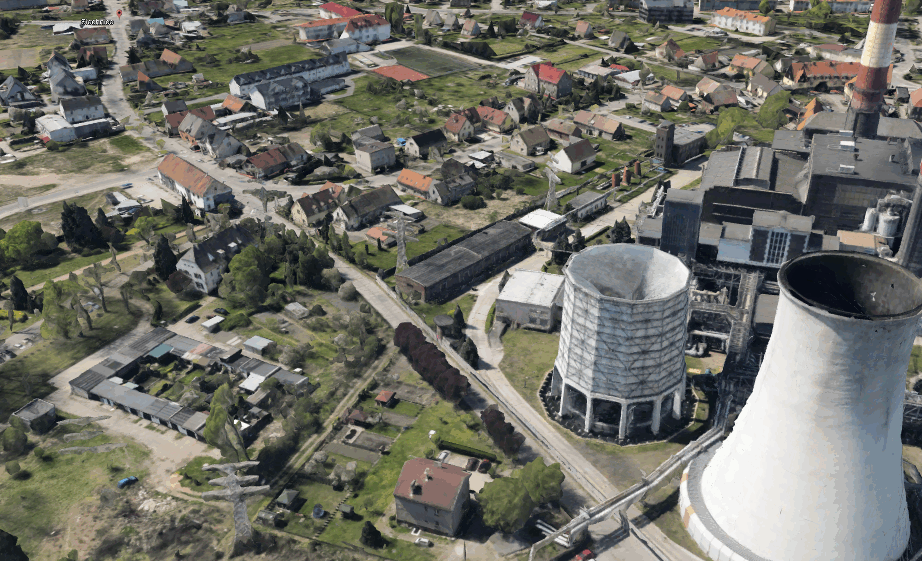 this is probably why they chose a swampy area. They needed the water. this is probably why they chose a swampy area. They needed the water.
Left, this Google gives you an good view of a small old-style industrial water cooling tower still in use in Poland. Its cement columned base is identical to those remaining from other German sites, such as Auschwitz. They were a prefab base for such towers.
The location of Altgolßen would make sense if the project had to be moved from one of the industrial areas in the south, possibly Gablonz. I mention Gablonz because it is situated near where the borders of Bohemia (northern Czechoslovakia), Poland, and Germany met. A move from Gablonz northward to Altgolßen is logistically possible. I also highlight Gablonz because an Austrian scientist, Viktor Schauberger, was seconded here to experiment with his energy vortex implosion technology which he encrypted into a device he called a “Repulsine.” It was essentially a vortex generator that required an external motor to jump start it. Once it got to 20,000 RPMs it was self sustaining. Surprisingly, however, it took off and hit the ceiling during one test.
Although some have tried to pronounce his invention an antigravity device, it is really a rather interesting energy generator. Toward the end of the war, the Nazis were largely concentrating on a big bang that could save the war for them. There is nothing like that in the Repulsine, but as an energy 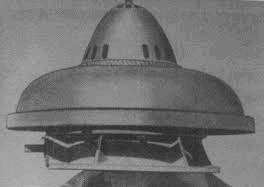 generator it is a fertile field for adaptation. generator it is a fertile field for adaptation.
Right, the Repulsine with and without its top intake cone.
Nazi wartime experiments in Wunderwaffen (“wonder weapons”) is a subject still clouded in much mystery because the S.S. destroyed everything they could before the Allies got to the scientific research and development facilities. And that which the Allies did seize and which had any postwar development potential remains jealously guarded. 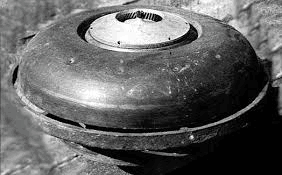
Polish journalist Igor Witkowski has basically come to own part of the genre— that part dealing with flying saucer experiments. He was allowed to see the interrogation records of one S.S. General Jakob Sporrenberg, who spoke before his postwar Soviet captors about experiments going on in parts of Lower Silesia, now a part of Poland but back then a part of Germany. This led Witkowski to other records and living Germans who could speak of a number of experiments dealing with the Wenceslas Mine facility near Ludwigsdorf. Most of this, as all followers of the genre know, surrounds the enigmatic Die Glocke (the bell), but of interest here is another experiment mentioned by Witkowski’s sources. This is “magnetic field separation.”
I don’t know exactly what this is supposed to mean, but from the visual provided for us by the Polish POW we know the basic premise of the Repulsine is no good to explain what he saw. The rapidly spinning midsection of the saucer and the stalling of the tractor motor all suggest the science of a magnetic sink, as it would later be termed by Wilbert Smith. However. . . .the motor to start such a rapidly rotating disc or band would konk out right away . . . unless . . ..
Putting Wilbert Smith’s theory together with the effects of a spinning disc designed to facilitate collapsing energy from the magnetic field yields a basic surmise. The power source for any such device would have to be magnetically separate so as not to be stalled by the eddy currents produced by the device on the whole. This does not sound like separation to me, but more like isolation, but I do not know exactly what magnetic field separation is.
Witkowski makes reference to the work of Yevgeny Podkletnov in Finland. In 1996, he discovered in his lab that spinning a superconductor in a cylinder reduced the weight of anything placed over it. Witkowski notes that a superconductor is diamagnetic— it does not interact with another magnetic field. Podkletnov also said he had been inspired by German wartime tests, in particular those of Viktor Schauberger.
Putting a number of clues and leads together, Witkowski believed that the German scientists were after a perfect energy source and that the facility in the old Wenceslas Mine was the center of the studies to create and perfect it. The tests surrounded Die Glocke, but he was also led to consider flying saucer propulsion because of a enigmatic looking structure colloquially called “The Henge” on the abandoned property. It is a huge circular columned cement structure reminiscent of modern testing rigs for vertical lift craft, such as helicopters. He is not alone in speculating that this was a test rig for a flying saucer.
However, as others have pointed out “The Henge” is clearly the base of an industrial water cooling tower. It’s a prefab structure, as many things were during the war, upon which was bolted the corrugated and flimsier superstructure making the cone or tower. If it could have doubled for such a test rig, I do not know. But its existence at the old secret German war site is neither proof nor disproof of the theory that the Wenceslas Mine facility was the center of truly outstanding wunder developments that had to do with flying saucer propulsion. Of course, those who want to believe in wonder weapons and Nazi flying saucers firmly believe The Henge heavily suggests that the Wenceslas Mine was the center of flying saucer developments.
Yet although there is no proof at the Wenceslas Mine, there is a corroboration by inference from the makeshift facility for the Schwemmteiche Saucer. We have an eyewitness here, and the intrinsics of his story bear upon the Wenceslas Mine facility. He implicitly associates a water cooling tower as a requirement next to a large outdoor area where the saucer sat and was worked on. This is where it was prepared and then launched. At the Wenceslas Mine, The “Henge” is next to a huge “parking lot” of wartime prefab cement slabs that together create a plaza large enough for a parade ground. Yet no structure set upon it. What was its use? With little leap, we can say the Polish POW’s description of the schwemmteiche layout is the same as is still preserved at the Wenceslas Mine. (In addition, Witkowski found channels for cables, and undoubtedly this was for copper cables coming and going from the cooling tower.)
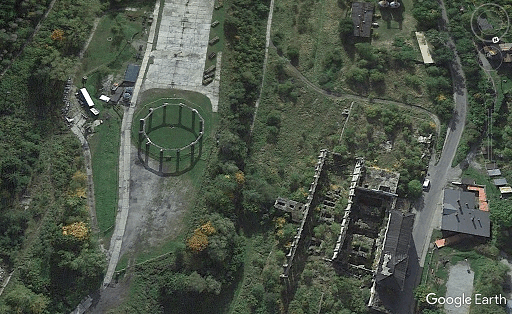
An example of how big the circular “Henge” is at Wenceslas Mine can be seen by comparing it to the gutted building next to it. The cement slabs are prefab and were brought in by the Nazis to make the roads and large square “parking lot” before the circular structure. Skimming over the valley on Google and following the cement roads shows how extensive the facility was (above ground).
The similarity between the two sites is purely visual. Both needed an industrial cooling tower, which is not a rarity at an industrial site. However, a large flat area next to the tower is a bit unexplainable.
We have no witnesses from the Wenceslas Mine facility speaking about a saucer being tested. This is perhaps because Sporrenberg was in charge of murdering 62 of the scientists and technicians in the last days of the war, according to Witkowski, to keep their knowledge from ever going to the Allies. Then, of course, there may have been nothing to remember, at least when it comes to flying saucers. Prague figures more in the collective German memories that both Lusar and Vesco tapped into. Then for Vesco, the launch of a saucer occurred from a small German town. The Polish POW certainly witnessed a launch from a similarly unimportant country hamlet.
From descriptions of tests and interpretations of the controversial Glocke the Wenceslas facility appears to have been working on something far more important than a saucer. Witkowski has concentrated more on nuclear, antigravity, or perhaps something still so revolutionary as a power source it is beyond our rationalization.
There is a subset of followers of the genre who love the cloak and dagger of hidden Nazi technology and what must be done to try and reveal its once-upon-a-time existence. In the hands of the Allied victors thereafter, according to the genre, it may have inspired some of the greatest aerospace developments. Enthusiasts love the whole idea of Die Glocke representing a time machine or a nuclear reactor or an engine that can generate antigravity. They also believe that uncovering proof, or even a heavy inference, that Nazi Germany secretly perfected flying saucers explains the entire phenomenon of the UFOs since 1947.
It’s a fascinating genre, and I don’t think devotees should be condemned. I’m not one of them, but from what I know very little has ever been done to really probe into the issue of German flying saucers. The reason why only narrow progress is made is because those seeking information do so along a very narrow pathway. Each limit themselves to the statements of Rudolf Lusar and interpret everything he wrote with some rather mundane plans that have later surfaced purporting to be blueprints of Nazi flying saucers. These plans are attributed to the names he mentions— Schriever, Habermohl and Belluzzo. Arguments surround how viable these plans really are and whether they were put into practice.
None bear any resemblance whatsoever to the disc seen rising at the schwemmteiche. Maybe they really are genuine saucer plans, but they appear to be junk. As titillating as some are presented to be, the designs really are junk. They show discs powered by cambered blades or ram jets around a revolving center rim. If they are real, there would be no reason for the allies to bring them to fruition if they had something the likes of what Vesco describes and what the Polish POW saw. This is underscored when Count Rudolf von Meerscheidt-Hüllessem offered some saucer plans to the Canadian government in 1952, along with the hope of a position and some money. He was rejected. The response came back that the plans were “outdated.”
According to Vesco, the British got the German flying saucer plans in the Black Forest and started developing them in the remote areas of Canada. If they already had something like the Schwemmteiche vehicle, then it can be well imagined that the common Germans blueprints, at least those that were not deemed worthy of Allied booty, wouldn’t impress them.
The idea that the current flying saucer phenomenon was based on secret Nazi wartime experiments started early, but found respectable sources in 1950 when the sightings of a dome with a rotating disc became very clear. It was an Italian who started the ball rolling. In March 1950, Dr. Giuseppe Belluzzo categorically stated in the Giornale d’Italia (repeated in in the London Mirror) that both Hitler and Mussolini were intrigued by such designs and as early as 1942 there was work and study on developing them. He said there was nothing Martian about the current reports. Rather he speculated that “some great power” was testing the designs based on new techniques. Rudolf Schriever was next. No doubt emboldened by Belluzzo’s comments, he soon came forward and said he was part of the work and even designed a saucer. Other names popped up— Dr. Richard Miethe and later Otto Habermohl. Based on these news events more than inside knowledge may explain some of Rudolf Lusar’s mistakes in his book. He noticeably gets Belluzzo’s name wrong, incorrectly spelling it Bellonzo.
Belluzzo had died in 1952, leaving a few Germans uncontested in their assertions about flying saucer technology. Their designs aren’t too impressive, if those designs later touted as their blueprints truly are theirs. Yet these blueprints form the base of the Nazi Flying Saucer mythos. Should they? There is no proof the obsolete designs attributed to them is what Belluzzo was talking about. He was higher placed than all the others. He had been a Senator, economist, and builder of the first steam turbine in Italy. His death merited an obit even in the New York Times.
Believers in Nazi flying saucers skip about the accounts of Schriever, and the concepts attributed to Miethe and Habermohl, like they formed a collective May Pole. As a result debunkers simply skip about the same May Pole but in the opposite direction and hope to knock down the believers. Neither may be in orbit around the actual work Belluzzo was referring to.
None of the plans ever presented can be compared to what the POW saw at work in the Swamp Saucer north of Altgolßen, a technology which seems to mirror far more advanced principles familiar to Wilbert Smith in Canada only a few years after the war. Vesco says there was a kugelblitz— a manned large version of the dazzling “Foo Fighters.” FOIA requests proved that USAAF Intelligence knew some of the details of the “Phoo Bombs” and that they were German. That 2-foot silver disc with vents and ports following the B-47 in 1957 heavily suggest the US got the plans after the war. It looks like Vesco’s description of the Feuerball, the baby of the kugelblitz.
Cloak and dagger must truly surround the development of saucers in America and possibly Canada. A specific type of saucer comes about at this time (1950)— the dome with the rotating disc. Wilbert Smith can easily explain the basics of its science and even warns of its hazardous electromagnetic effects. Avro Canada attempts to build a working saucer for commercial use and famously fails. But failure wasn’t necessarily because of design. It was power source. It was to be conventional, nothing electromagnetic. From all accounts, the electromagnetic source would require the pilot and cockpit electronics to be isolated (Faraday Cage), and as we see here even the power source that starts the “magnetic sink” would need to be isolated so as not to stall from the massive eddy currents. Commercially this is untenable.
Spy craft, however . . . ?
On October 21, 1965, over Minnesota we get a clear example of a working flying saucer along these principles. It is seen clearly through binoculars and photo’d by deputy sheriff Art Strauch. It is not a conventionally powered craft. This is certain. Yet there are some basic similarities to Avro’s conventional design. The central rotating turbine is replaced by the rotating disc, but the air scoop remains in front. However, the power source is clearly something electromagnetic. The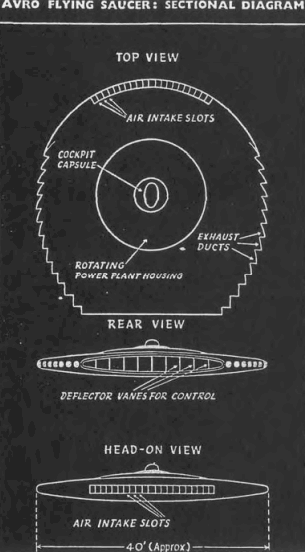 saucer is encased in a tight clinging plasma glow, but even in the photograph what appears to be an air scoop vent opening in front is delineated. Strauch saw this clearly through the binoculars. saucer is encased in a tight clinging plasma glow, but even in the photograph what appears to be an air scoop vent opening in front is delineated. Strauch saw this clearly through the binoculars.
Frankly, Strauch saw something far more logical in design than anything offered by Avro or the (supposed) German designs. He sees a saucer that is more dome than disc, with only a short lip around it. Avro and so-called German saucer designs reflect SCI-FI impressions of saucers as having a central dome with a 20 foot diameter disc around it. With such a design, the visibility of the pilot is severally hampered, especially for objects (including his landing base) close at hand. The saucer Strauch saw clearly reflects basic practicalities absent in the others. The saucer Strauch saw and photographed worked because it had an electromagnetic source of energy and an unobstructed view for the pilot.
Did such technology come from the Germans? Nazi Flying Saucer buffs would have us believe so. Pro-ET theorists say it comes from a crashed alien UFO. But neither are necessary.
Another Canadian, Dr. Fernand Roussel, had proposed electromagnetic energy in a 1943 paper (Unifying Principles of Electromagnetic Energy). German scientist O.C. Hilgenberg published a scientific paper in 1931: About Gravitation, Vortices and Waves in Rotating Media. Combined, it is obvious more than one nation’s scientific establishment knew of the potential that existed and could have been working laterally along the same lines without being influenced by the other. But if the Germans had perfected a saucer and its electromagnetic generation, as the Schwemmteiche Saucer suggests, this becomes a “proof of concept” and nothing influences developers and government purses more than that.
O.C. Hilgenberg’s former teacher had been Dr. Walter Gerlach, who later specialized in nuclear physics. Igor Witkowski would come across Gerlach’s name associated with the Wenceslas Mine activities.
From just a cursory knowledge of the science involved, coupled with the POW’s account, the experiments near Altgolßen can be viewed as a natural evolution of these concepts. It’s almost certain 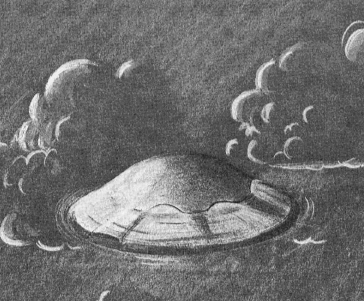 something electromagnetic was ongoing in the schwemmteiche. If even a short flight was attained, which it seems there was, a “proof of concept” had been startlingly achieved. something electromagnetic was ongoing in the schwemmteiche. If even a short flight was attained, which it seems there was, a “proof of concept” had been startlingly achieved.
Based on Strauch’s guidance, Richard Beal drew this saucer as representing what he saw through binoculars. It was published first in 1965 by A.P.R.O.’s Bulletin.
It is reasonable to surmise that by the time of the experiments north of Altgolßen, the Germans had come onto a better design for a saucer than those that have come down to us attributed to German engineers. From Belluzzo we know they were studying flying discs, but what this entails we don’t know. We have to accept the witness at Altgolßen as reflecting its fruition.
What might have intrigued the German command about Schauberger’s Repulsine was that it became self-sustaining after reaching 20,000 RPMs even when the external electric motor was disengaged. Its unique internal design allowed for a vortex implosion to maintain itself, something like a tornado that never dissipates. As a source generating electromagnetic/“gravitational” lift, it could last for days. This is a perfect fuel source. It’s a machine design that sustains a caged tornado, and tornados have electromagnetic power. This source would continue to spin the disc. The disc would be feeding off the magnetic field. All it needed was an internal electric motor to start the process. But this motor would have to be in a separate and isolated condition. Likewise the pilots would have to be ensconced in a cockpit— essentially caged in a “Faraday Cage.” A saucer would not be a wunderwaffe, but a wunder delivery system. The Germans might have thought this would be a great design to carry a nuclear bomb long distances. Or, if Vesco was right, something this powerful could fulfill what the little brother Foo Fighters couldn’t— stall formations of Allied bombers.
This is something Herr Himmler, the head eccentric butcher of the S.S., would have thought of value. After all, if I recall correctly, as the Reich was collapsing in flames he digressed during peace talks with Count Bernadotte to give a 30-minute dissertation on runes, of which he considered himself quite a student.
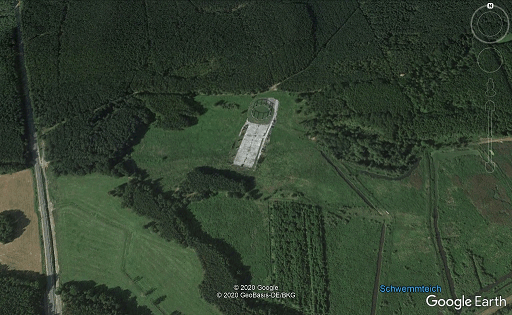
From near the same altitude (100 feet off) the Wenceslas Mine henge superimposed on part of the schwemmteiche north of Altgolßen. It gives the reader a sense of the size of the swamp.
With Allied spies everywhere and daylight bombing, it is not surprising the S.S. would move to a remote area by a swamp and build a makeshift test site. This follows other S.S. practices at other development locations. The above move from Vienna to Leonstein is a case in point. Also, there was a problem with spies. That spying was a serious problem for German technology is evident at the end of the war. Many German scientists expressed their surprise when allied officers approached them, ready to recruit them, and seemed to know all about their experiments and where they had taken place. The collective conclusion was the Allies had perfected corporate spying.
But no such plans have ever come forward detailing the disc or power source used in the tests at Altgolßen. So far, we have only one picture matching what Vesco called the disc-like Feuerball trailing a 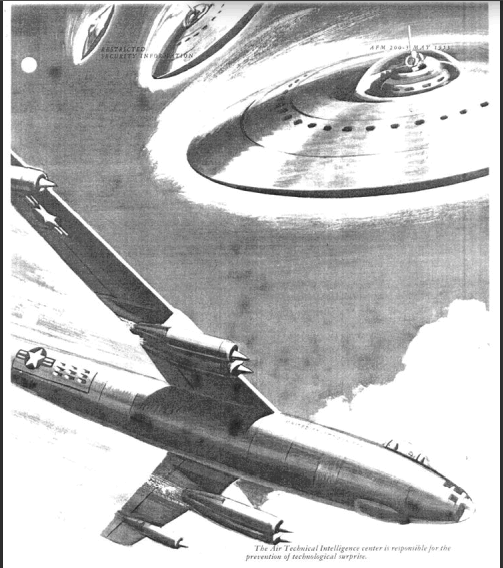 B-47 in 1957, indicating the US got some of the technology. B-47 in 1957, indicating the US got some of the technology.
. . .Well, actually there is one more. Much excitement was created in October 1961 when NICAP’s The UFO Investigator broke the story that in May 1953 USAF Air Technical Intelligence manual AFM 200-3 carried the illustration of a flying saucer. This manual had been restricted. Pro-ET believers wondered if the design wasn’t based on inside knowledge of official (and top secret) photographs and close up pilot sightings of flying saucers. Is this what one truly looked like?
The caption reads: “The Air Technical Intelligence center is responsible for the prevention of technological surprises.”
With hindsight now, the curiosity should be directed at wondering how much of the Schwemmteiche Saucer design might actually be reflected in the illustration. The illustration was never qualified in the manual, but the entire discussion of the chapter (chapter 9) was about technological surprises from foreign countries. “The air war in Europe was marked by continuous development and evolution. This process did not stop with VE Day; great strides have been made in machines, weapons and techniques. No greater or more dangerous mistake could be made than to assume that the same polices and practices that won the war in Europe will be sufficient to win the next one.”
Is the illustration merely symbolic tongue-in-cheek of technological surprises? Yet the artist seems remarkably informed on the same principle the Polish POW saw and would try to explain to the F.B.I. in 1957. The saucer is in three major sections, with the central section slotted and separate and therefore capable of spinning.

One of my incarnations of what the POW saw in 1944 at the schwemmteiche. It’s a bit fanciful, but he doesn’t describe it in detail. It probable looked like the saucer in the AFM 200-3 manual below, right.
From 1949 we have photos and descriptions of flying saucers with spinning discs, but no one has pursued their origins despite the pattern of their sightings around US aerospace developers like Boeing. If the basic design came from the German Schwemmteiche saucer, the US had reason to fear other powers (Soviets) also could have the designs. There was more, therefore, than tongue-in-cheek symbolism to put so accurately a designed saucer in the restricted security manual. 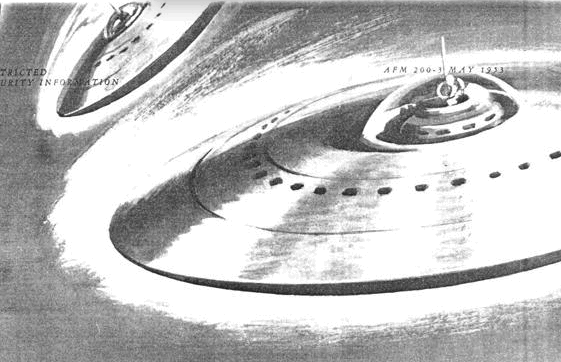
The S.S. destroyed as much as they could during their retreats, and this seems to account for why the POW saw the test location near the swamp completely leveled after the war. If plans or persons involved survived, no Allied power has admitted to getting them. From collating later saucer reports, we can only say this schwemmteiche saucer is an early example of a rotating disc generating some level of flight, and also creating the power interruption in other electric devices nearby— something to come into play in the UFO phenomenon most notably at Levelland in 1957, the incident which inspired the former Polish POW to come forward.
From what I’ve read nothing is really certain about the facility at Wenceslas Mine. However, because of an eyewitness at Altgolßen we know a similarly described set up was required for the last stages of launching a saucer. The POW’s testimony carries some weight because it fits with independent comments (made later while the F.B.I. report was still restricted) from both Vesco and Lusar about the development and launching of at least one saucer, one that according to Vesco probably generated a lot of electromagnetic power as a giant version of a foo fighter.
If the basic “proof of principle” or its plans was in British hands first, as Vesco insists, how could it most immediately have been modified to allow a pilot? Several clues actually come together to suggest the rumors Vesco (and several others) picked up on were true. The British were the first with a secret flying saucer modified from German designs. Let’s go to Cambered Clue.
|